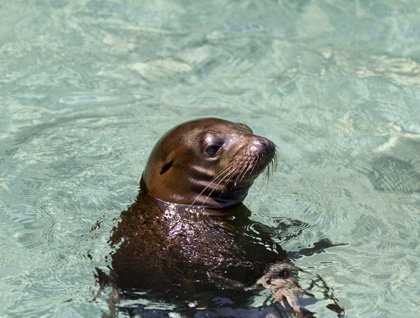This morning we awoke to find the National Geographic Islander anchored off an extensive lava flow that dates back to 1897. Historians were able to exactly date this flow from the written log of a whaling vessel that was in the area at the time of the eruption.
We spent the entire day around this lava field, which stretches for many square miles. In the morning, we took a Zodiac ride along the shoreline and then snorkeled in this same area. In the afternoon, our naturalists led us on a lava hike across the rough, amazingly varied and interesting lava flow.
Breakfast was served at 0700 and at 0800 everyone boarded our fleet of four Zodiacs, each accompanied by a naturalist. We cruised the shoreline of Santiago and the expanse of rough black lava that is only 116 years old. We spotted noddy terns and soaring Galápagos shearwaters when we entered a shallow cave on the coast of Sombrero Chino. This island is aptly named, by the way, as from a distance it truly does have the shape of a Chinese hat!
Later, along the black lava shores of Santiago, we found several striated herons. (They are still called lava herons in some of bird books, but have recently been reclassified as striated herons.) The herons were crouched above the water waiting to grab an unsuspecting minnow. Marine iguanas basked in the early sunshine, warming up in preparation for a morning feed. Being reptiles their body temperature depends on the ambient temperature. They feed almost exclusively on marine algae and can get very cold while diving in the ocean. So this morning they were warming up before diving to feed.
Some of us saw a lone penguin zipping around in the water, chasing a school of tiny 2”-long fish. I spotted the penguin from a distance by noticing a flock of noddy terns diving above the penguin as he chased the tiny fish to the surface. We did not get a very good look at the penguin as he popped to the surface only very briefly to take a breath before he continued chasing fish.
We returned to the ship and wiggled into our wetsuits and headed out for snorkeling. Naturalist Jonathan took a small group of guests to a lovely beach where they relaxed and swam and enjoyed the company of sea lions. The snorkelers had a fantastic outing! By now the marine iguanas were sufficiently warmed up and we found several of them a meter or so under the water, holding onto the rocks and grazing on the marine algae. To find, watch and even photograph feeding marine iguanas is a real treat! Nowhere else on earth can one see this because marine iguanas are only found in the Galápagos. It is a sight that still excites even a naturalist since we are rarely lucky enough to find grazing iguanas when we go snorkeling!
We swam among many species of fish and found a shark sleeping in an underwater cave. Near the end of the outing we spied a diamond sting ray and a second white-tipped reef shark. By then we were completely chilled. Some of us chose to head to the beach while others went straight to the ship for a hot shower.
The afternoon hike began at 1530 following lunch, siesta, and my presentation about living on Volcan Alcedo doing research for my PhD. Three group of hikers set off to explore the pahoehoe lava field and we took countless pictures of the endless textures of the lava. There was little plant or animal life on the lava even after more than 100 years—only a few species of pioneer plants and lava lizards and finches. But we thoroughly enjoyed the walk and were again pleased that each outing has been unique. There are always new and interesting things to see every day in the magical Islas Encantadas!









